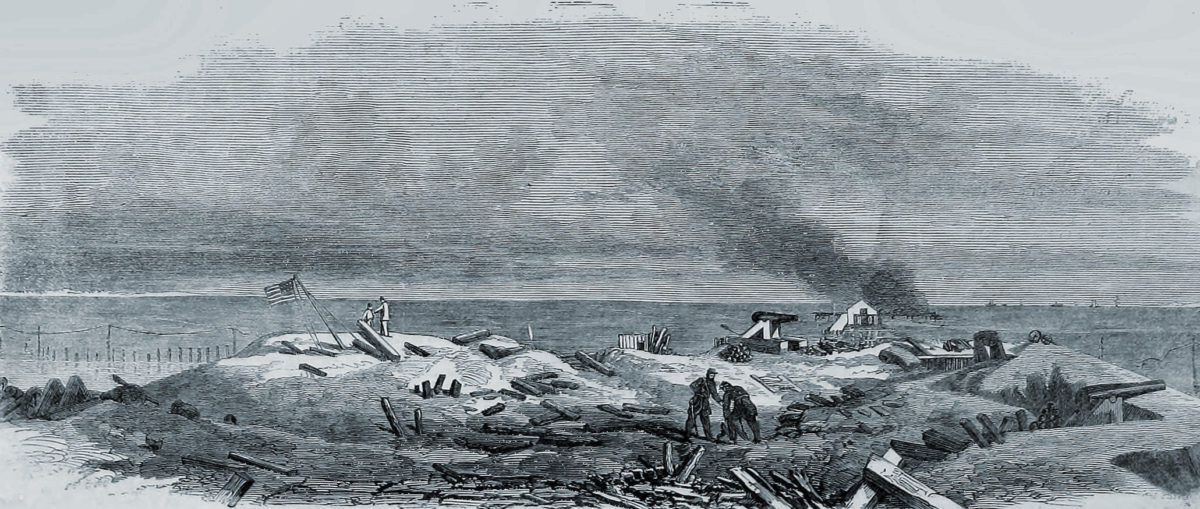In the wake of the disastrous Red River Campaign in the spring of 1864, the Union 19th Corps was recalled from the Department of the Gulf to help in the Eastern Theater, embroiled in heavy fighting. Union commanders Maj. Gen. E.R.S. Canby and Adm. David Farragut were, of course, displeased with the loss of these valued troops but were not deterred in continuing their campaign against the Confederate stronghold of Mobile, Alabama. In the strategy they formulated, Farragut would secure Mobile Bay with his naval vessels while Canby launched land-based attacks on the multiple forts that surrounded the city. Although many of these fortifications, some erected prewar, were already well-known to the Yankees, a few defenses among the lot were new and a mystery.
The known forts around Mobile and Mobile Bay that Canby and Farragut had their eyes on were Fort Gaines, Fort Morgan, Fort McDermott, Fort McIntosh, Spanish Fort, Fort Alexis and Red Fort. Two other earthen fortifications had been built during the war, dubbed Battery Tracy and Battery Huger. Fort Powell — named for Confederate Col. William L. Powell, who died on Sept. 9, 1863 — was another newly built structure.
Not present on most Union maps in the summer of 1864 were three obscure redoubts, later to be known formally as forts and named in honor of Confederate generals who had been killed in action earlier in the war. The first was Fort Mouton, originally simply called Battery B. It honored Brig. Gen. Jean Jacque Alfred Alexandre Mouton, killed at the Battle of Mansfield, Louisiana, in April 1864.
GET HISTORY’S GREATEST TALES—RIGHT IN YOUR INBOX
Subscribe to our HistoryNet Now! newsletter for the best of the past, delivered every Monday and Thursday.
Mouton’s Life
A son of Alexandre Mouton, the former Louisiana governor, Mouton graduated 38th out of 44 in West Point’s class of 1850. At the Civil War’s inception, Mouton had formed the 18th Louisiana Infantry, earning the distinction of being a strict disciplinarian in drill but a friend when relaxing. After training at Camp Moore, Louisiana, Mouton and his regiment were sent north to join Confederate forces in Mississippi. He would be wounded at the subsequent Battle of Shiloh in April 1862.
While recovering from his battle wounds, Mouton’s unit was ordered back to Louisiana. There he became a trusted principal in Maj. Gen. Richard Taylor’s army in western Louisiana. By the 1864 Red River Campaign, Mouton had been promoted to brigadier general and led a division of Louisiana and Texas units. Despite many different accounts, all parties agree that Mouton was killed while at the front with his men. Battery B became Fort Mouton less than a month later.
Serving at or near a site named after Mouton was a particular honor for the Louisiana troops in Mobile, many Shiloh veterans themselves. Reported The Mobile Tribune: “A salute of thirteen guns, in honor of the trans-Mississippi victories, was fired at Fort Mouton by detachments of the 1st Louisiana regiment artillery and 22nd Louisiana volunteers, under the direction of Lieut. Col. Beltzhoover.”
A similar salute was fired at Fort Morgan, and in 1865, Adm. Raphael Semmes had a marble slab placed at Fort Mouton with the inscription, “In honor of Brigadier General Alfred Mouton, the Hero of Mansfield”—the first monument erected in honor of a Confederate.
FOrmidable Redoubts
Fort Mouton had been built as a square earthworks redoubt, with two bastions facing Mobile’s outer line of defenses. The parapets were 15 feet to 25 feet thick, and a tidewater ditch 30 feet wide and a whopping 20 feet deep was dug. Protecting a large centrally placed magazine were eight 8-inch Columbiad cannons, bolstered by 24-pounder, 32-pounder and 42-pounder siege guns. It was garrisoned by the aforementioned 1st Louisiana Artillery and a portion of the newly designated 780-man 22nd Consolidated Louisiana Infantry (now trained and serving as artillerists).
Information, however, on the other forts named after Confederate generals is mostly lacking. What was originally Battery K was renamed in honor of Maj. Gen. J.E.B. Stuart, mortally wounded at the Battle of Yellow Tavern and dying May 12, 1864. Similar to Fort Mouton, the fort honoring Stuart was a square earthworks redoubt with four bastions and central magazine. There were mounts for seven heavy cannons.
The third redoubt-turned-fort honored Gen. Albert Sidney Johnston, struck down at Shiloh: formally Fort Sidney Johnston. Originally known as Oven Bluff Battery, it covered the approaches to Mobile via the Tombigbee River, with 12 bluff-top heavy guns. It was not until mid-April 1865 that Confederate forces retreated from the Mobile defenses and the aforementioned forts were abandoned.When it looked like Fort Sidney Johnston would be overrun, the magazine was blown up by its defenders and abandoned.
Recent research into an expansion proposed by the Alabama State Port Authority discovered the remains of Fort Sidney Johnston that appear to be 230 feet by 300 feet. As one of the consulting archaeologists noted: “It’s kind of one of the last things built by Confederate engineers. The preference is always not to dig them and just preserve them.” Thus, the mystery continues.
historynet magazines
Our 9 best-selling history titles feature in-depth storytelling and iconic imagery to engage and inform on the people, the wars, and the events that shaped America and the world.


